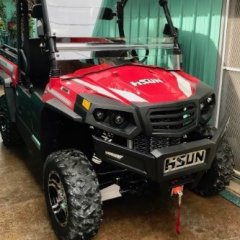-
Similar Topics
-
By davebuckholts
I just picked this UTV up off of Marketplace. It needs batteries.
I am installing a single 48v lithium battery.
The on board charger, a NOCO Genius GX 4820, has a lithium mode.
Has anyone here used this charger on new lithium batteries? I want to be certain of the compatibility before hooking the charger to this expensive battery. **
**
I got in touch with NOCO and they told me the charger is fine to use on a new LiFePo battery.
Nice charger. Many modes. New ones are running about $550.
-
By GunnersTacklebox
Hi All,
New here, but bought a 2022 Sector 750 brand new last march (old stock up here in Canada)
It's a good bike so far, but I have noticed a quirk and was wondering if anyone else has had a similar issue?
The issue I've had is if I leave the utv parked on any incline, not even a major incline, and leave it to sit for a while (day or two) it will not start properly. It will turn over and not fire until I press the gas pedal, when it will run and rev up, but if I let off the gas it will die. It will keep doing this until I either start it in gear and drive it for a bit or leave it in neutral and roll it down the hill to flatter ground. where it will have to sit for a while.
If I park it on a decline there is no issue. fuel is not low, it's occurred a couple times now.
Any thoughts on the cause of this? Dealership just says bring it in and let them take a look, at my expense of course.
-
By HighSon
This mod is not for the fainthearted, as it requires some basic metal fabrication and welding skills. But the result is worth the effort IMO. I chose an aftermarket Honda Talon windshield based on economy, size, and construction (aluminum frame, DOT glass, folding, windshield). It fits OK, a little narrow at the top, and you need to incorporate the lower section of the original acrylic windshield and build some additional plates, but better than being too wide. If you are wondering why I attacked this mod, it's because mine is driven daily on the street. Tired of fading, scratchy, hazy plastic. Sucks in the rain; sucks at night. Now I can see.
-
By Jon Spruill
Hey Guys, I have been chasing a stalling condition for about two weeks now. The bike will crank up and idle fine, then after about 20 seconds it will fall on its face and stall. It happens at both idle and while running at various rpms. You can turn the key off, turn it back on and it will fire right back up without trouble. I have verified spark on both cylinders with a spark tester. I have also added an inline fuel filter, and pulled the injectors to verify proper pulse on each. Things I have replaced - (relearn procedure performed after each component replaced): spark plugs, ECU, relay/fuse box, fuel pump, & throttle position sensor - all with no improvement of the condition. The only warning light I get when the condition occurs is the oil lamp. The bike only has 14 miles. I am at a loss and appreciate any help and suggestions! Thanks

-
By Gorj
I am going to replace the batteries in my E1. I am not interested in the high cost Lithium or the expensive 6 volt dry batteries. I am considering four 12 volt deep charge marine batteries. I have a source for 810 amp units for about $100 each. I have no worries about reprograming the charger because it went out a few years ago and I replaced it with generic golf cart charger. When I decide to do this, I'll keep you posted on the results.
-










Recommended Posts
Join the conversation
You can post now and register later. If you have an account, sign in now to post with your account.
Note: Your post will require moderator approval before it will be visible.